Although male bettas can never be kept together, these are intelligent fish that loves company.
Not every species is compatible with these feisty fish.
So, what fish make the best betta tank mates? What unusual betta fish tank mates can you choose? And can female bettas make good tank mates?
Read this guide to learn the 57 best tank mates for betta fish.
Betta Tank Mate Checklist
When choosing suitable tank mates for your betta fish, there are a few considerations you need to keep in mind:
- Check that the species you want are suitable for the tank size you have.
- The tank mates must all share the same water parameters as your betta buddy, especially the temperature. For example, goldfish can’t live with bettas because they’re coldwater fish, not tropical species.
- Brightly colored fish and those with flowing fins are best avoided, as your betta could easily mistake them for another male betta.
- Avoid any fish that are confirmed fin nippers.
Ideally, you want to choose fish and other creatures that enjoy the same diet as each other and your betta fish. That means you won’t have to spend money on lots of different kinds of food and helps to prevent food waste.
57 Best Betta Tank Mates
In this part of our guide, we check out 57 of the best companions for your betta buddy.
10-Gallon Tank Mates
The following critters all make suitable betta tank mates for life in a minimum tank size of 10 gallons.
Amano Shrimp (Caridina multidentata)

Amano shrimp are a good choice for a 10-gallon setup, provided you use lots of dense planting and give the shrimp plenty of hiding places.
These little shrimp grow to around 2 inches long and spend most of their time foraging for food in the tank, helping to keep the environment clean and tidy.
Dwarf Crayfish (Cambarellus genus)

These little crayfish grow to measure around 2 inches long and get along fine with betta fish.
Ensure the crayfish have plenty of hiding places to keep them relaxed and happy. Crayfish are best kept in small groups of three to prevent them from competing for food and territory.
Corydoras Catfish

There are over 150 species of Corydoras catfish. These little fish grow to around 3.5 inches long, depending on the species, but all are peaceful characters that make an excellent addition to a community tank.
Kuhli Loach (Pangoi kuhlii)

These pretty 3 to 5-inch-long fish are pretty much nocturnal, hiding away during the daylight hours in crevices and underneath rocks.
We recommend keeping only a single Kuhli loach in a small betta aquarium.
Female Guppy (Poecilia reticulata)
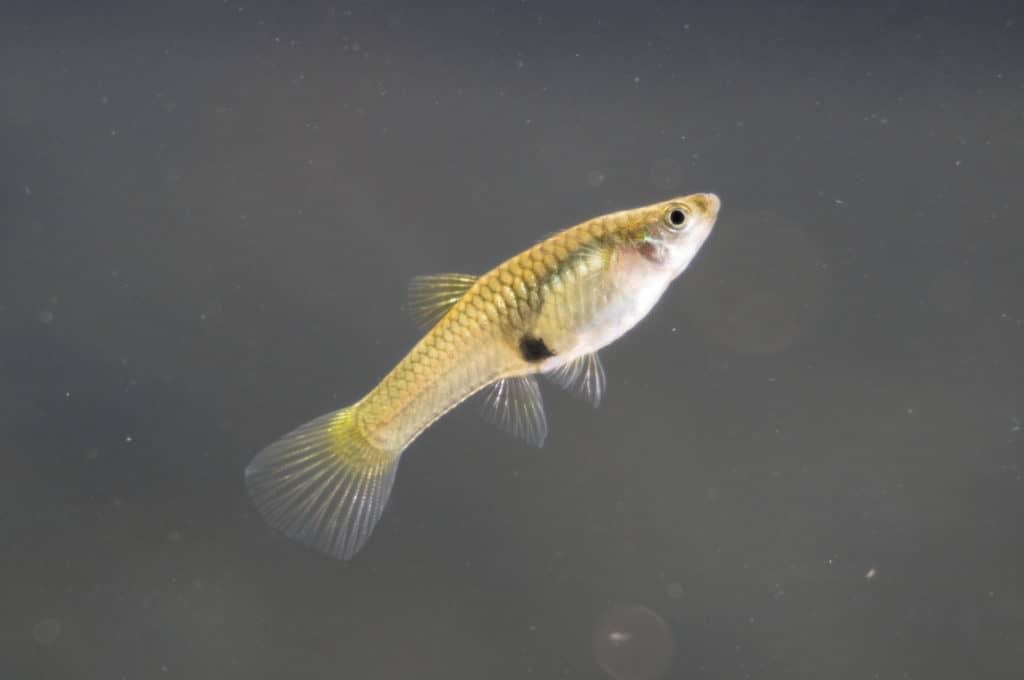
Female fancy guppies can reach around 2 inches long. Although females lack the flashy tails of their male counterparts, they are usually compatible with betta fish, but we recommend planting your tank so that the girls have somewhere to hide if your betta gets too interested in them.
Pygmy Corydoras Catfish (Corydoras pygmaeus)

The Pygmy cory is a gorgeous little fish that doesn’t grow more than an inch or so long.
These shy critters like to hide around plant bases on the substrate, occasionally darting to the water’s surface to grab a mouthful of air. In a small betta tank, you can keep up to three pygmy corys.
African Dwarf Frogs (Hymenochirus curtipes)

African Dwarf frogs can make an unusual betta tank mate. These completely aquatic frogs only get to around 2.5 inches long and are great fun to watch.
You won’t see much of the frogs during the daytime, but they come out at night to float on the water’s surface. A small betta tank can fit up to three frogs with your betta fish.
Otocinclus Catfish (Otocinclus vestitus)

These little schooling catfish will spend their time grazing on the algae growing in your tank and on natural plants, helping to keep the aquarium clean and tidy.
You should keep Otos in groups of at least three in a tank with sufficient space, as these friendly fish can be shy if isolated.
Platy Fish (Xiphophorus)
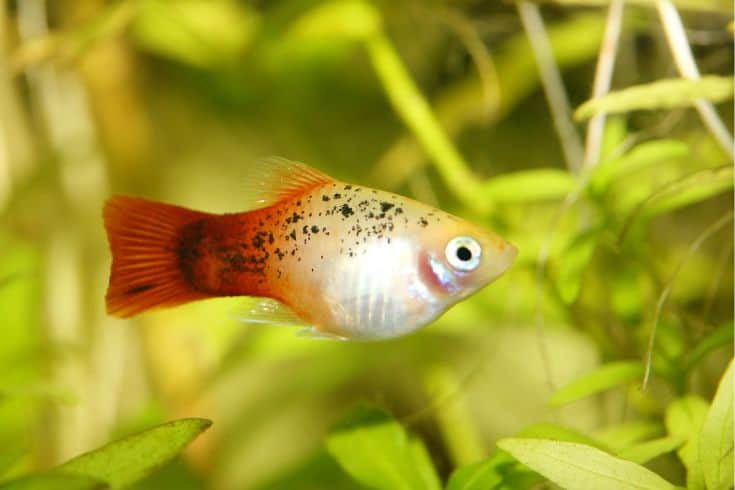
Platys are excellent community fish that get along fine with bettas. These peaceful livebearers grow to around 3 inches long and come in a range of colors, adding activity and vibrancy to your viewing experience.
Harlequin Rasbora (Trigonostigma heteromorpha)
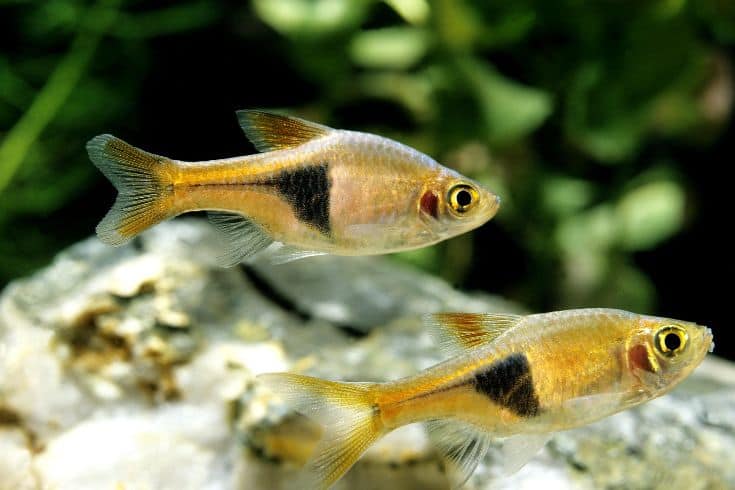
These friendly fish reach a length of around 2 inches and do best when kept in schools. That said, three Harlequins will do fine in a well-planted 10-gallon tank with a betta.
Clown Plecostomus (Panaqolus maccus)

Clown plecos are eye-catching bottom-dwellers that can grow to around 3.5 inches long. The fish graze on algae and will happily finish up your betta’s leftover food, too, helping to keep your tank tidy. Note that a 10-gallon tank is only big enough to house one Clown pleco.
Shortfin Molly Fish (Poecilia)
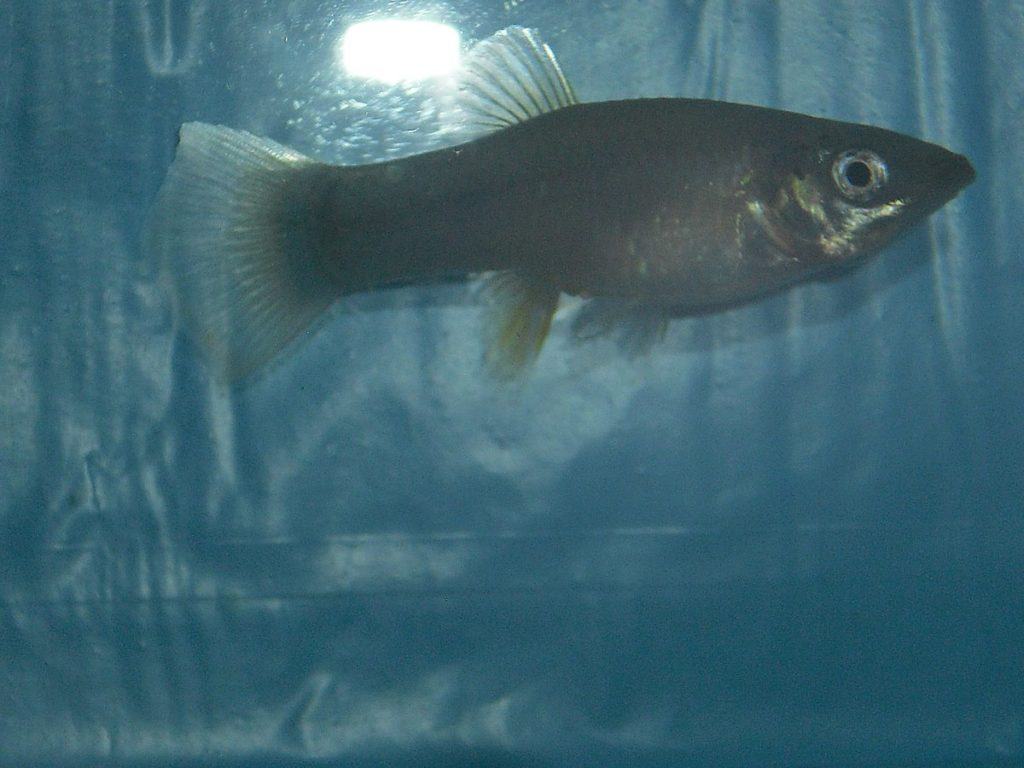
There are several different species of Molly fish, all of which come in a wide range of colors and patterns. These livebearers are prolific breeders, but your betta will probably eat most of the babies, so overcrowding is not generally a problem.
20-Gallon Tank Mates
If you have a larger 20-gallon betta tank, you have a great choice of betta tank mates to consider for a setup of this minimum tank size.
Dawn Tetra (Aphyocharax paraguayensis)

Dawn tetras are unusual little fish that can make a nice addition to a larger betta tank. These can be feisty fish that do best when kept in schools of at least 15 individuals.
Green Neon Tetra (Paracheirodon simulans)

I love this beautiful little tetra and once kept a school of 12 of them in a tank with a betta. Reaching only 1 inch in length, Green Neon tetras look best when kept in large, dramatic shoals.
Columbian Tetra (Hyphessobrycon columbianus)

Although these attractive little tetras can be aggressive toward each other, they tend to be more peaceful when kept in large groups, which also creates a spectacular sight in the aquarium.
Silver Tip Tetra (Hasemania nana)

Silver Tip tetras are small 2-inch schooling fishes that enjoy a soft water environment, although they are pretty tolerant of a wide range of conditions. Ideally, you want to keep at least six of these peaceful tetras.
Head and Tail Light Tetra (Hemigrammus ocellifer)
Head and Tail Light tetras are personal favorites of mine. These peaceful community fish are great candidates for life in a betta tank and look stunning when kept in large groups.
Diamond Tetra (Moenkhausia pittieri)

Diamond tetras are beautiful, shimmering little fish that are the perfect complement to a glamorous betta! These tetras only reach 2 inches long and can do well if kept in a large group to dissuade your betta from attacking them.
Black Line Rasbora (Rasbora borapetensis)

Black Line rasboras can make an excellent addition to a larger betta tank since these powerful swimmers prefer to live in large groups of ten fish or more. Just like your betta, these rasboras prefer heavily planted tanks with a slow current.
25-Gallon Tank Mates
If you have a large 25-gallon tank for your pampered betta pet, these fish species can make the ideal tank mates for him.
Cherry Barb (Puntius titteya)

Cherry barbs are peaceful barbs that are actually quite shy and timid. If you have a larger tank, these gorgeous fish can add a spectacular pop of color when kept in groups of ten or more. These barbs will shoal together for safety and won’t hassle your betta.
Fire Rasbora (Rasboroides vaterifloris)
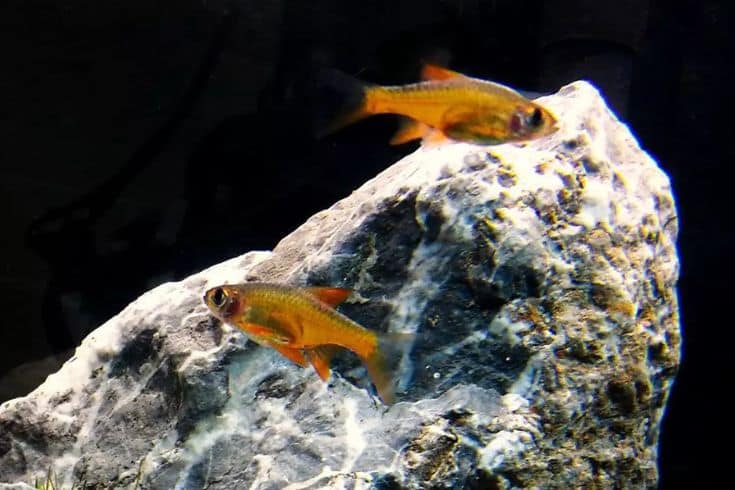
Fire rasboras grow up to 2 inches in length and do best when kept in schools of six or more. With their bright orange-red bodies, Fire rasboras can sometimes provoke a male betta, but they usually do fine when kept with a betta sorority.
Neon Tetra (Paracheirodon innesi)
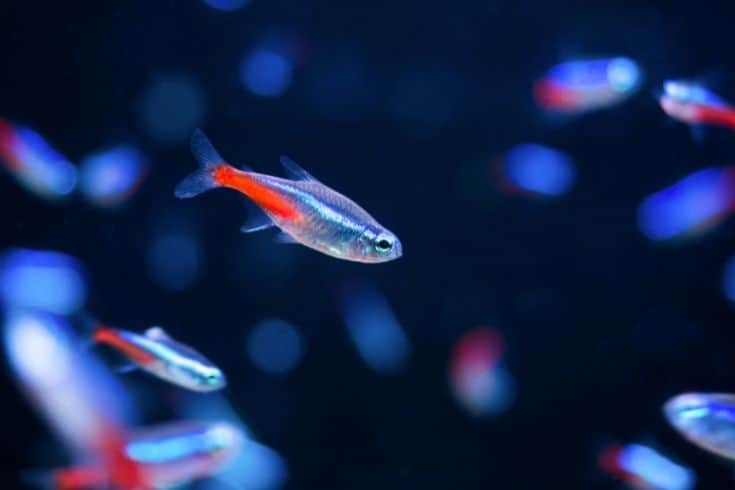
These swimming jewels are a perennial favorite in most beginner community aquariums. Neons only grow to around 1¼-inches in length and do best in large groups of ten or more. Although Neon tetras can sometimes trigger aggression in male bettas, they usually get along fine with a betta sorority.
Glowlight Tetra (Hemigrammus erythrozonus)

Glowlight tetras look incredible in a dimly-lit tank with plenty of heavy planting, so your large betta tank can make the ideal environment for them. These shoaling fish will happily school together for safety and are happiest when kept in groups of at least five individuals.
White Cloud Mountain Minnow (Tanichthys albonubes)
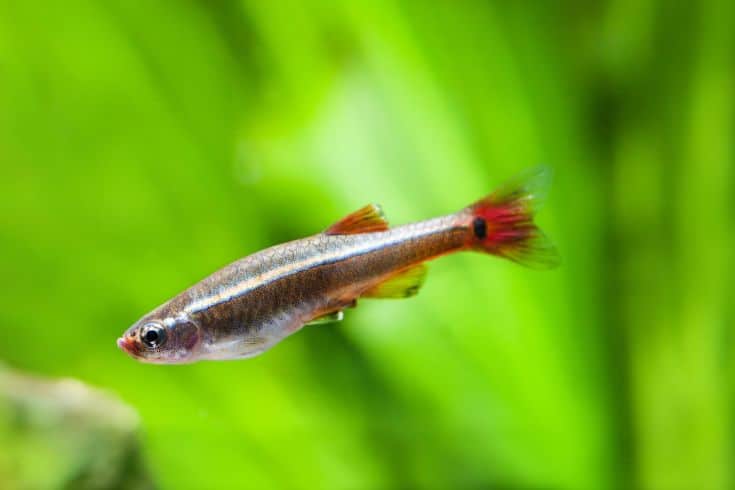
White Cloud Mountain minnows grow to around 1.5 inches long and can look spectacular in your large betta tank when schooling in large numbers. White Cloud Mountain minnows enjoy life in a large school in a well-planted tank with plenty of swimming space.
Celestial Pearl Danio (Celestichthys margaritatus)
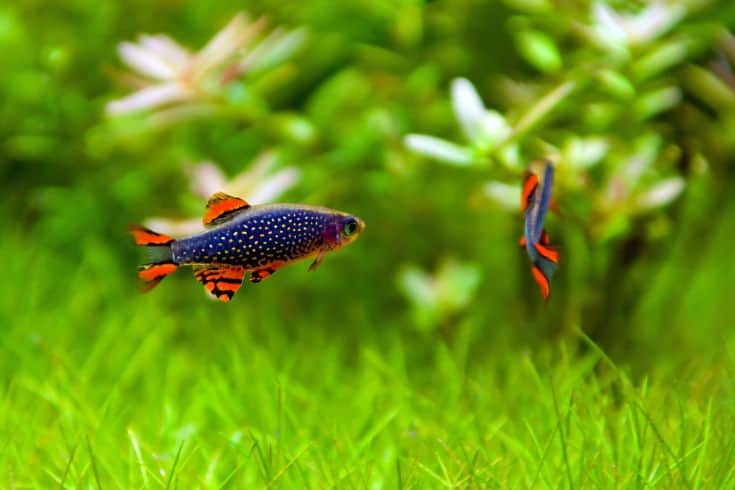
Celestial Pearl danios grow to a length of around 1 inch and make an eye-catching addition to a well-planted community tank or betta sorority when kept in large groups of at least ten.
Mosquito Rasbora or Chili Rasbora (Boraras brigittae)

Mosquito or Chili rasboras are shy schooling fish that come from the forested waters of Southeast Asia. You can replicate the fishes’ natural environment by using dim lighting and floating natural plants, both of which suit bettas, too.
Keep the fish in groups of ten for best results.
Penguin Tetra (Thayeria boehlkei)

Penguin tetras get their common name from the black stripe on their tail and body, giving them the look of a penguin. These tetras grow to around 3 inches long, preferring heavily-planted tanks with plenty of hiding places and open swimming space.
Rummy Nose Tetra (Hemigrammus rhodostomus)

Rummy Nose tetras can make a dramatic addition to a betta tank, especially when kept in large groups.
These fish grow to around 2.5 inches long, creating a spectacular sight as they weave in and out of a large school and dart among the natural plants and decorations in your betta tank.
Zebra Danio (Danio rerio)

Zebra danios are another favorite with aquarists and are often seen schooling in numbers in large community tanks. These fish can get along okay with bettas if kept in a large tank.
Lambchop Rasbora (Trigonostigma espei)

Lambchop rasboras are also sometimes called False Harlequin Rasboras, as the two species look pretty similar.
These fish are easy to care for and do well in a large, heavily planted tank if kept in groups of six to ten. For that reason, these rasboras are not suitable for life in a nano betta tank.
Blue Tetra (Boehlkea fredcochui)

Blue tetras are a great choice if you want a pop of color in your community tank. However, these are not the best choice for a tank with a male betta as they can be fin nippers. That said, Blue tetras can do well in a betta sorority tank.
Cardinal Tetra (Paracheirodon axelrodi)
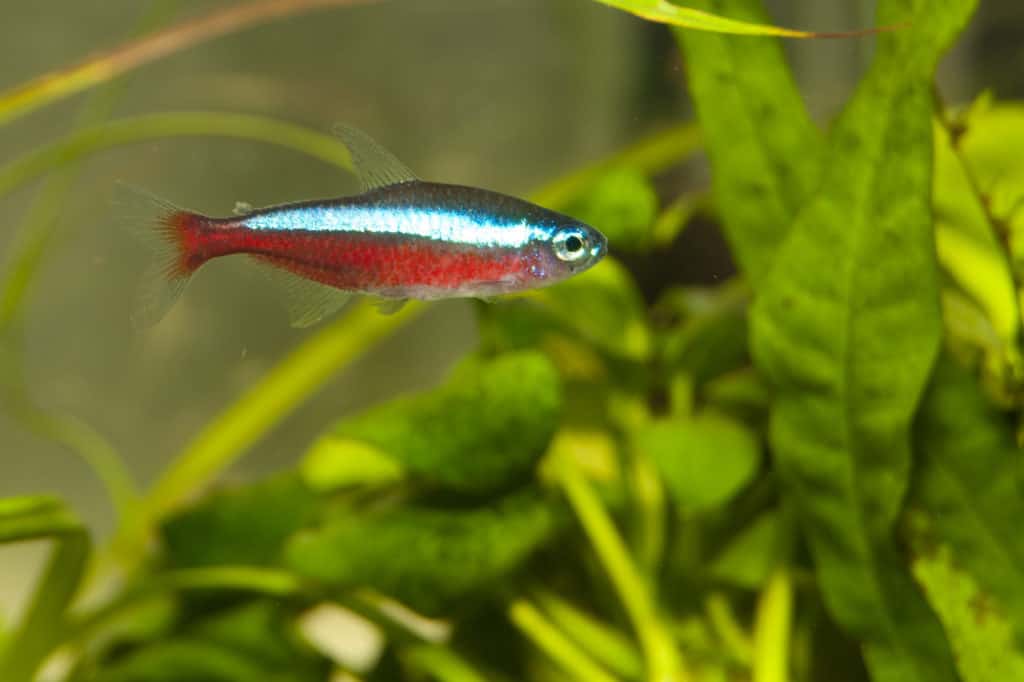
Cardinal tetras look very much like Neon tetras, although they are slightly larger and not as hardy. These pretty little fish make a lovely display when kept in large groups in a roomy tank with lots of swimming space and natural planting.
Gold Tetra (Hemigrammus rodwayi)
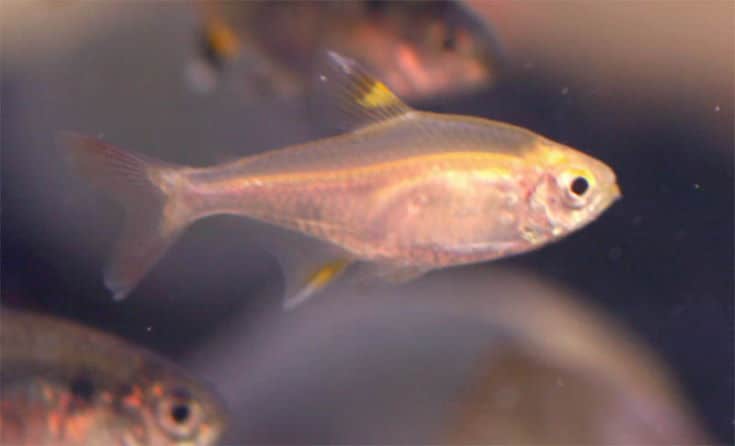
Gold or Golden tetras have a gorgeous metallic sheen to their scales that looks amazing when the fish are displayed in large groups of up to ten. Although the tetras’ bright colors can sometimes trigger aggression in male bettas, they can be okay if kept with a betta sorority.
Ember Tetra (Hyphessobrycon amandae)

Ember tetras rarely grow to more than ¾-inch, but their amazing, bright orange color makes up for that!
The vibrantly colored Ember tetra does best in heavily planted tanks with a group of female bettas rather than a single male.
Red Eye Tetra (Moenkhausia sanctaefilomene)

Red Eye tetras grow to around 3 inches long and have a brilliant crimson spot over each eye, which gives the fish their common name. These tetras do best in a larger size tank with plenty of space but can do well with male betta fish and female bettas too.
Black Neon Tetra (Hyphessobrycon herbertaxelrodi)

Black Neon tetras are another of my personal favorite fish. These understated tetras get along fine with other tetra species and do well in a community tank. If you have a large betta tank, you can keep large schools up to 10 strong, making it a spectacular sight.
Male Betta Tank Mates
By now, you must have a few ideas for good betta fish tank mates. Here are a few more to consider if you have one male betta living on his lonesome.
Zebra Loach (Botia straita)
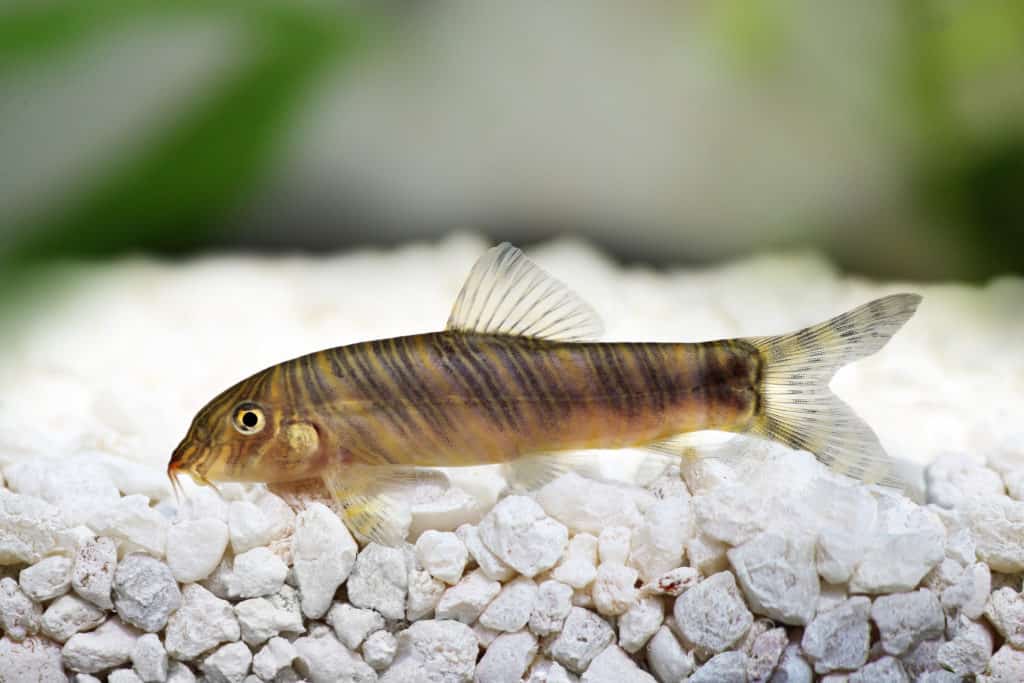
Zebra loaches are also sometimes sold as Candy Stripe loaches. These bottom-dwelling scavengers can live in groups of three to five individuals with a male betta, provided you give them plenty of hiding places and dense planting where they can seek shelter if they want to.
Albino Corydoras Catfish (Corydoras aeneus)

Albino corys make the perfect addition to a peaceful community tank, growing to around 2 inches long and preferring a densely planted tank. Corys are bottom-dwellers, so they won’t interfere with the betta that prefers to hang out in the upper area of the water column.
Ideally, corys of all kinds should be kept in groups of five or more of the same species.
Bristlenose Plecostomus (Ancistrus cirrhosus)

If you have a betta tank of 30 gallons or more, you might want to keep a Bristlenose pleco with your male betta fish. These peaceful bottom-feeders won’t hassle your betta buddy, spending much of their time foraging around the substrate or hiding among plants.
Candy Stripe Plecostomus (Peckoltia vittata)
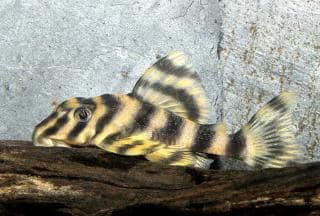
Bottom-dwelling species make excellent betta fish tank mates since they won’t hassle your betta or compete with him for food or swimming space.
Candy Stripe plecos grow to around 5 inches long and can do well as the only pleco in a 25-gallon tank or larger with no other bottom-dwellers.
Upside Down Catfish (Synodontis nigriventris)

Your betta buddy won’t be the star of the show if you decide to add a few Upside Down catfish to your collection!
You’ll need a tank of over 20 gallons to accommodate a few of these catfish, but they’re well worth having in you have sufficient space. These weird fish prefer to swim inverted, scavenging for food on the underside of your decor and plant leaves.
Female Betta Fish Tank Mates – Sororities
If you have a betta fish sorority, what compatible tank mates are the best choice? Here are some of our favorites.
Assassin Snail (Clea helena)
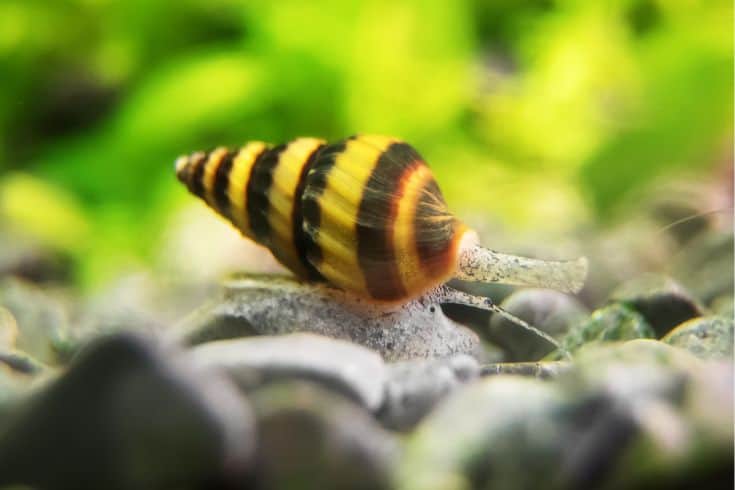
Invertebrates make a nice addition to a betta tank and will do fine as female betta tank mates.
These little brightly-colored snails help control other snail populations by preying on eggs and juveniles, as well as keeping your tank tidy by eating detritus on the tank bottom.
Snowball Plecostomus (Hypancistrus inspector)
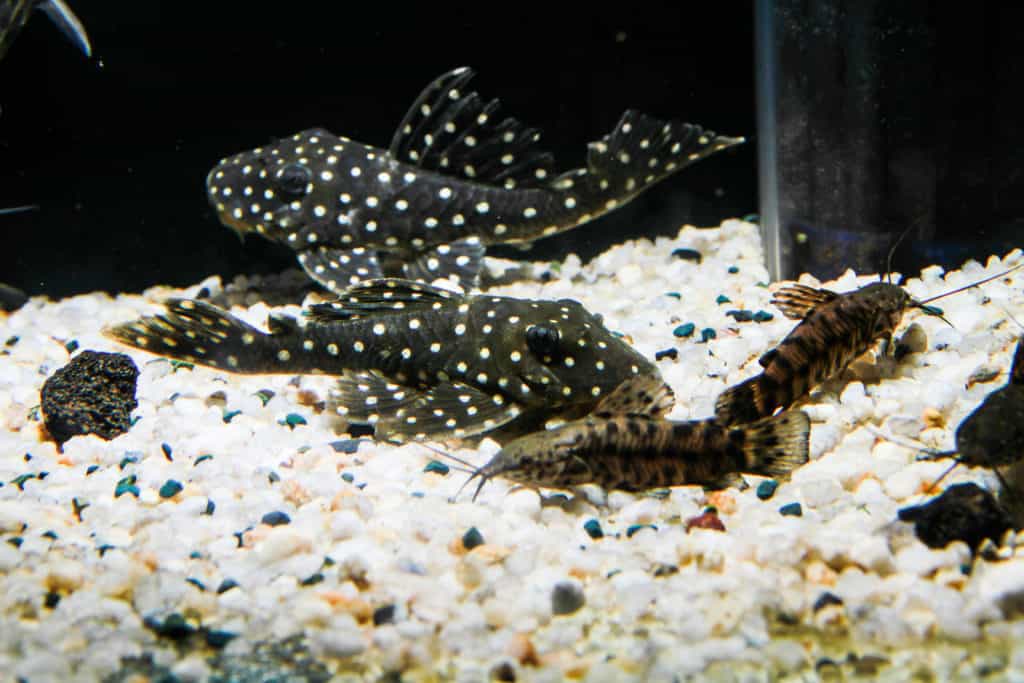
Snowball plecos are a peaceful species that make perfect tank mates for a group of female bettas in a larger aquarium over 25 gallons.
These plecos will graze on food leftovers and organic waste on the tank bottom, helping to keep the environment clean and tidy and improving water conditions for your other tank residents.
Plecostomus (Hypostomus plecostomus)

Common plecos are huge fish that can grow to reach 24 inches long at maturity. However, you can often keep a smaller juvenile pleco in a tank of 50 gallons or more for a few years until it gets too big.
These guys are often sold as suitable for smaller tanks, but you must be aware that they grow pretty quickly. In addition, Common plecos begin peaceful, but they can develop an aggressive nature as they age.
Yoyo Loach (Botia almorhae)
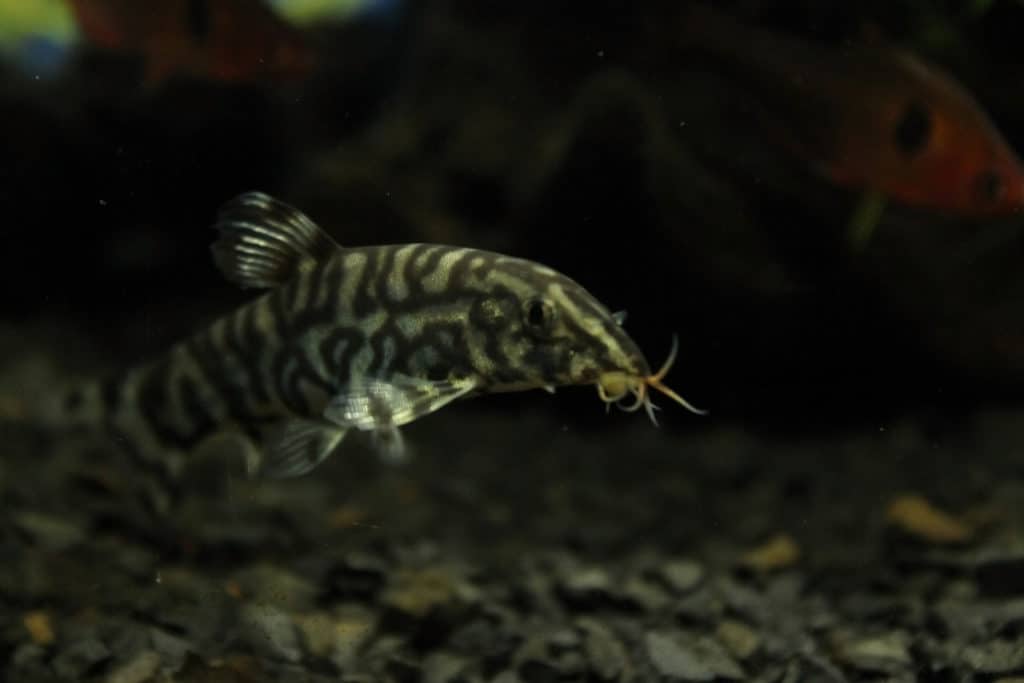
Yoyo loaches are colorful fish that only reach around 2 inches in length, making them suitable for a smaller tank setup. These cute little guys can become territorial in conspecific groups, but territorial disputes can usually be avoided when the fish are kept in a spacious environment in schools of five or more.
Guntea Loach (Lepidocephalichthys guntea)
When given proper care, Guntea loaches can grow up to 6 inches long, resembling freshwater eels, although they are fish. These loaches need a densely planted tank with plenty of places to hide and should be kept in groups of at least three.
These loaches get along well with other peaceful fish in a large community tank.
Clown Loach or Tiger Botia (Chromobotia macracanthus)

If you keep a large betta sorority in a 75-gallon tank or more, adding a few Clown loaches can be a good move. These brightly colored, peaceful fish grow up to 12 inches long but are social creatures that need to live in groups of at least five.
Panda Cory Cat (Corydoras panda)

Panda corys make a fun addition to a large, peaceful community tank, and they can be good companions for female betta fish sororities.
Like other cory varieties, these guys need a densely-planted tank and a soft substrate that won’t damage their barrels. Keep Panda corys in groups of at least six individuals of the same species, and they will thrive.
Glass Catfish (Kryptopterus vitreolus)

Glass catfish are transparent, so you can see right through them! That means you get a view of the fish’s internal organs and skeleton, which I think is pretty cool.
You’ll need to keep these fish in a school of five to ten to give them a sense of security, as they can be quite shy. These unusual, entertaining fish usually get along well in a betta fish sorority.
Other Tank Mates
Here are a few other tank mates that can get along well with a solitary male betta fish or a female betta sorority.
Mystery Snails (Pomacea bridgesii)
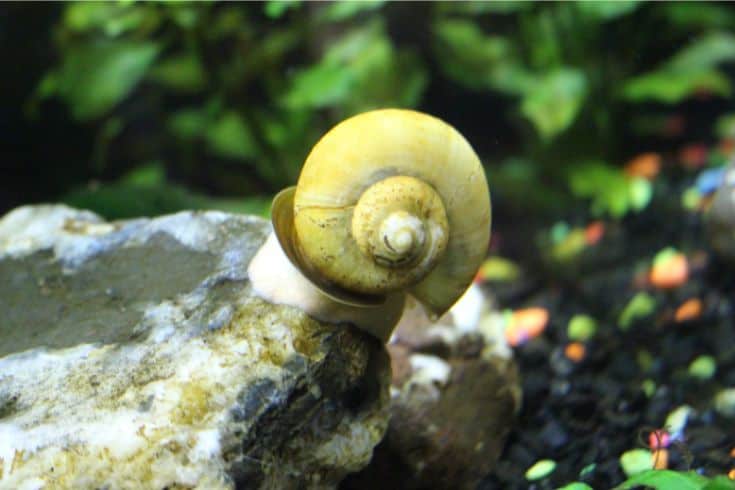
Mystery snails are 2-inch-long brightly colored inverts that can make a good addition to a betta tank. These peaceful gastropods graze on algae and detritus, helping to keep your tank clean while providing company for your betta fish.
Nerite Snails (multiple species of Neritina)

Nerite snails are crawling, eating machines that can do a wonderful job of keeping your tank clean. The snails have attractive, striped, and multi-patterned shells and can reach up to 2 inches in diameter, making one snail suitable for life in a small tank.
Zebra Snail (Neritina natalensis)

The Zebra snail is a variety of Nerite snails that has a stripy zebra pattern, hence its name! You can also find these snails with swirling patterns for variety. Like most other nail varieties, the Zebra snail can make a good tank mate for bettas of both sexes.
Ramshorn Snails (Planorbarius corneus)
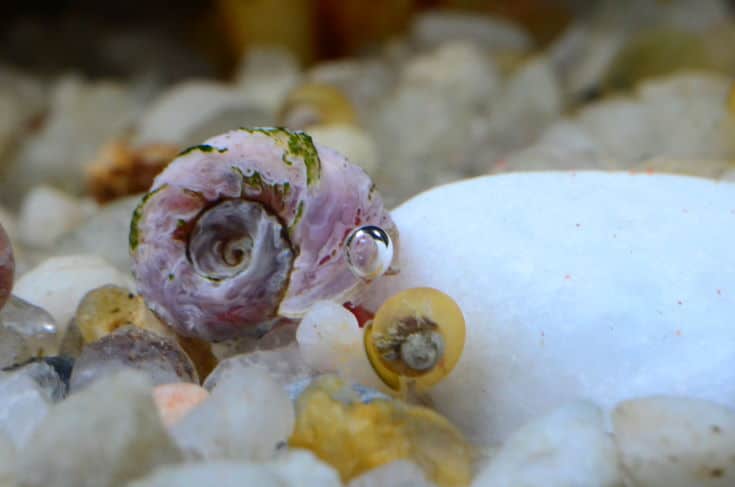
Some people regard the Ramshorn snail as a nuisance pest in their fish tank, whereas others love them. These snails are easy to breed, come in a variety of different colors, and usually do well in small tanks with a betta and a few shrimp.
Malaysian Trumpet Snails (Melanoides tuberculatus)

Malaysian Trumpet snails are one of the most popular and common freshwater aquatic snail species in the hobby. These are peaceful creatures that get on fine with bettas of both sexes, although sometimes, a betta might make a snack out of the smallest juveniles.
Adult Cherry Shrimp or Red Cherry Shrimp (Neocaridina heteropoda)

I don’t recall having a tropical tank without a few of these lively shrimp in it, and I love their vibrant colors! Adult Cherry shrimp only grow to measure around 1.5 inches long and get along fine with most small fish, including bettas.
Be sure to provide the Cherry shrimp with lots of hiding places and thick planting to keep them happy.
Ghost Shrimp (Palaemonetes paludosus)
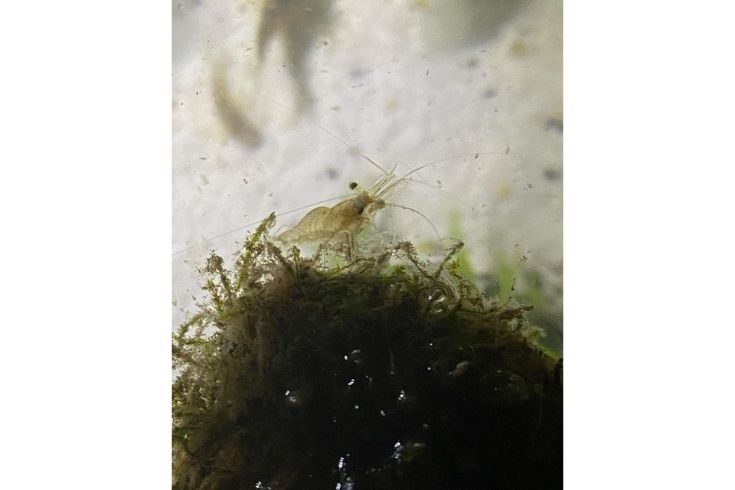
These tiny shrimp can grow from ½ to 2 inches long, having a clear shell that you can see right through! You’ll see these little guys lurking around the bottom of your tank, feasting on algae and general detritus.
Although adult Glass shrimp get along fine with betta fish, they can be vulnerable to predation by larger fish.
Endlers Livebearer (Poecilia wingei)
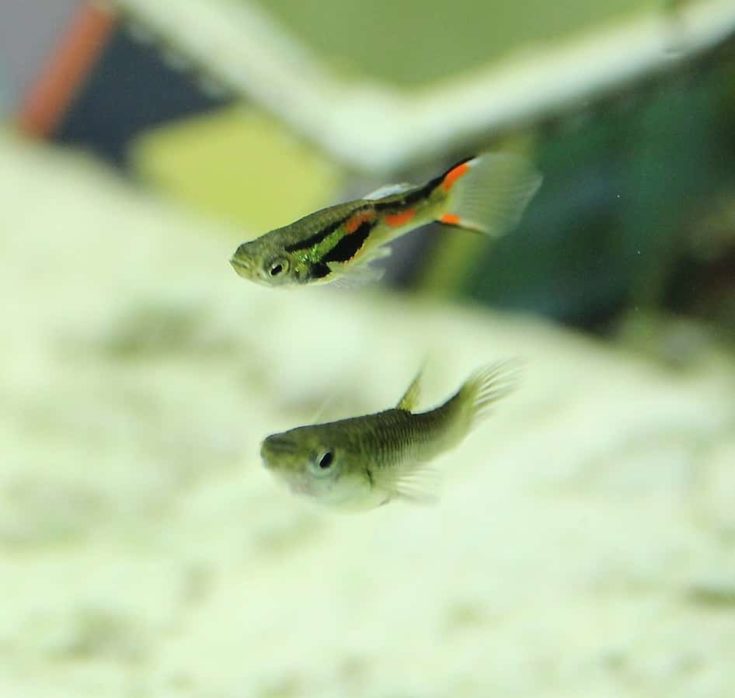
With their peaceful nature, Endler’s livebearers can make an excellent addition to a betta tank, being small and pretty but without the fancy tails of fancy guppies that can sometimes trigger aggression in male bettas. These brightly colored fish can do well in a nano tank or a five-gallon aquarium.
FAQs
Here, we answer some commonly asked questions about betta tank mates
Q: How many betta fish can I put in a 5-gallon tank?
A: A 5-gallon tank is a perfect size for betta fish. But you should only ever keep one male betta in a tank of any size.
Betta fish are fiercely territorial, and they will fight if kept together.
Q: Can a betta have tank mates in a 5-gallon tank?
A: Yes, there are plenty of small fish and invertebrates, such as Ghost shrimps or Mystery snails, that can live with your betta fish in a small, 5-gallon tank.
Q: Do bettas need tank mates?
A: Bettas are intelligent fish who get lonely if kept without companionship. You can mitigate that somewhat by providing your fish with toys, imaginative planting, and plenty of places to hang out and rest.
However, often, a companion or two can perk up a betta fish that’s bored or stressed. That said, every betta fish is different, and some are more sociable than others.
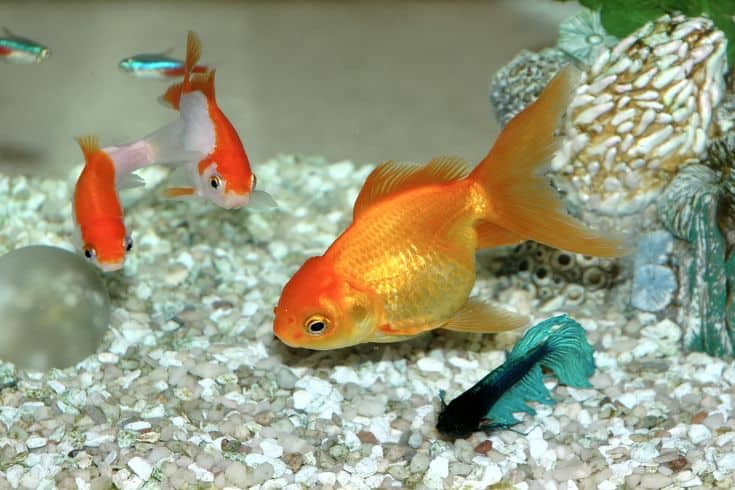
If your betta is extremely aggressive, he might not tolerate anything else in his domain. In that case, it’s up to you to entertain and stimulate your pet!
Q: Can I put two bettas in the same tank?
A: Absolutely not! Bettas are not called Siamese Fighting fish for no reason! These fish are highly territorial and aggressive toward other male bettas. If you put two betta fish in the same tank, they will certainly fight, sometimes to the death.
Final Thoughts
I hope you enjoyed our guide to 57 of the best tank mates you can choose for betta fish. If you did, please share the article before you go.
Male betta fish must be kept separately. However, these intelligent fish need lots of mental and physical stimulation to keep them happy. Sometimes, the addition of a few shrimp or snails is all it takes to perk up a bored betta. You might even fancy trying to start a small betta breeding project by introducing some female bettas to the mix.
What tank mates does your betta buddy share his aquarium with? Tell us about your pet in the comments box below.

Thank you so much Jen ! This was very informative and helpful. I’m new to this and I really needed your article. Feel much more confident in my ability to make an educated choice of fish for my beta.
Thanks for information, very helpful indeed! 🙂 I was wondering if you are aware of multiple shoaling fish causing Betta stress? I was hoping to add male Betta to 105 litre tank with school of 12 white cloud minnows (6 golden and 6 normal) and a school of 6 rasboras ( these ones haven’t been decided or purchased yet as I’m unsure about the multiple schools causing Betta stress). I just wondered if you had any experience of this at all? Many thanks in advance, all the best for the New Year 🙂